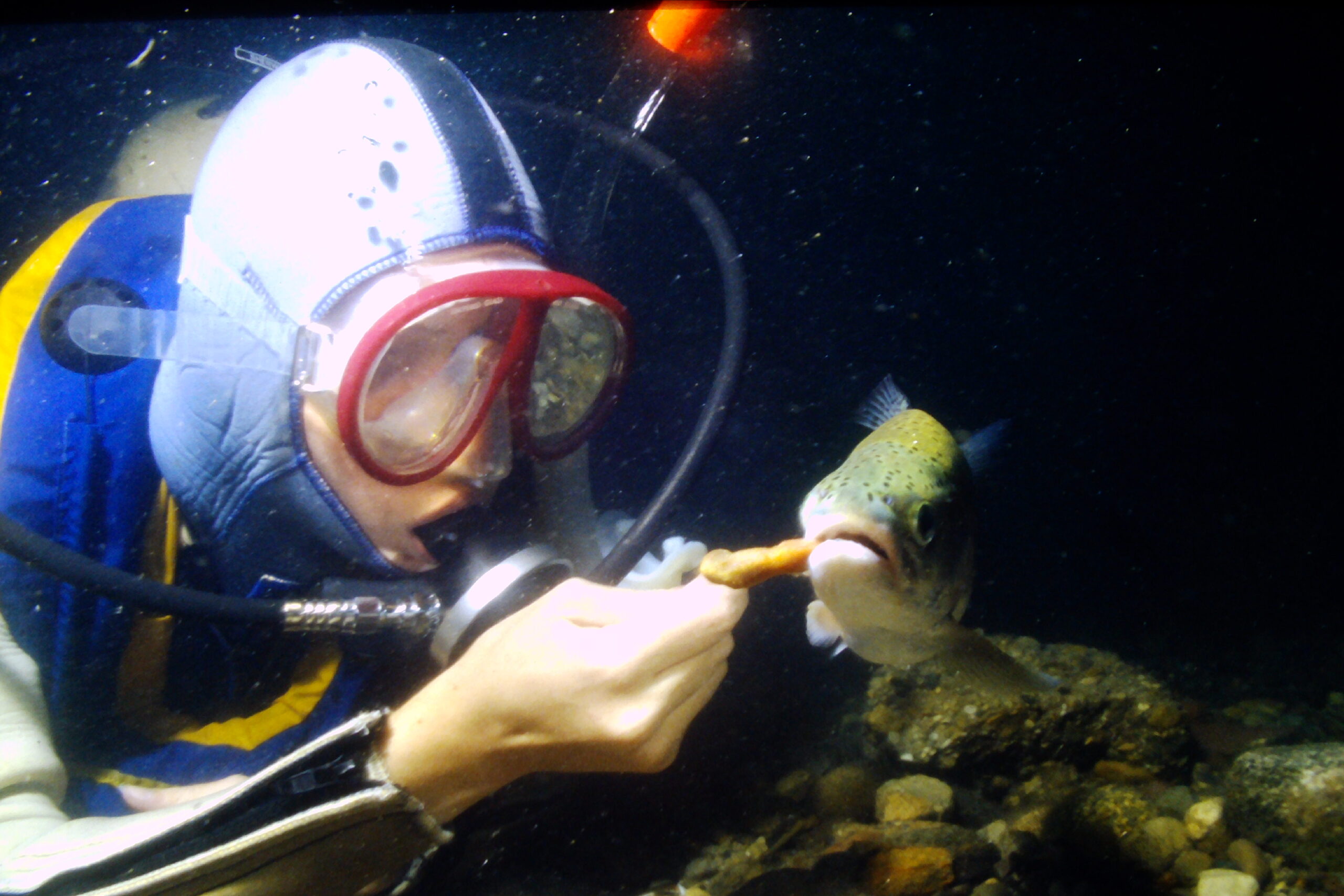
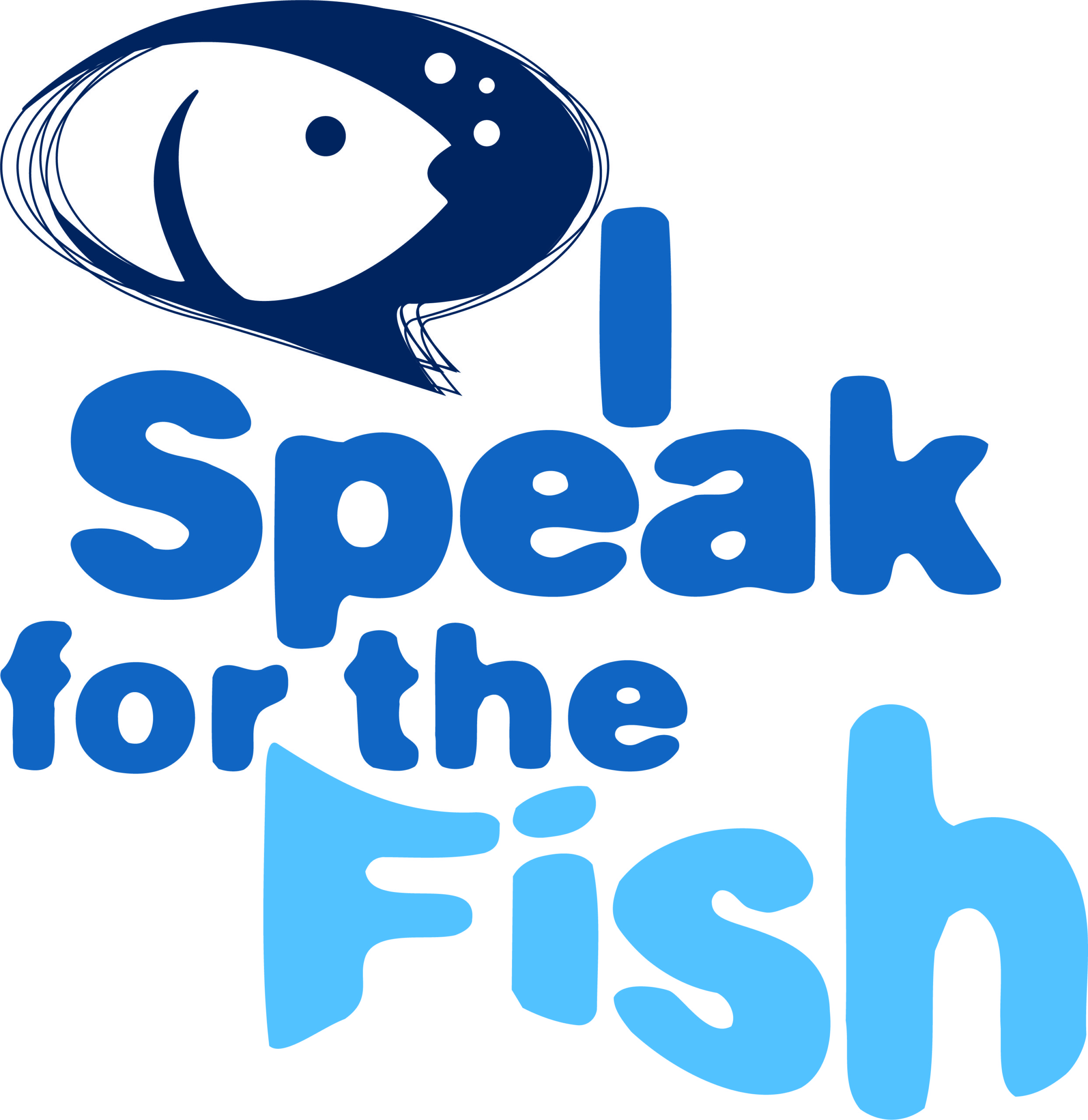 I Speak for the Fish is a monthly column written by Great Lakes Now Contributor Kathy Johnson, coming out the third Monday of each month. Publishing the author’s views and assertions does not represent endorsement by Great Lakes Now or Detroit Public Television. Check out her previous columns.
I Speak for the Fish is a monthly column written by Great Lakes Now Contributor Kathy Johnson, coming out the third Monday of each month. Publishing the author’s views and assertions does not represent endorsement by Great Lakes Now or Detroit Public Television. Check out her previous columns.
For 30 years, I’ve been feeding fish. It’s one of my favorite things to do while diving. I try on almost every dive. I’m successful maybe 75% of the time.
Surprisingly, I’ve found that all fish do not like the same food and some won’t eat the same thing two days in a row. It can be super frustrating and highly rewarding. Often on the same dive.
I’ve found what you offer makes a difference. How you offer it makes a difference. When you try makes a difference. Where you try matters. And some days, no matter what you do the fish won’t bite.
Over the years, I’ve fed bluegill, rock and smallmouth bass, rainbow trout, steelhead, walleye, round goby, logperch, a variety of minnows and shiners, and a few mudpuppies.
The first Great Lakes fish I hand-fed was a rainbow trout. It was so successful it set the bar so high that it’s taken me decades to achieve a similar experience.
It finally happened last month.
Breaking Bad Habits
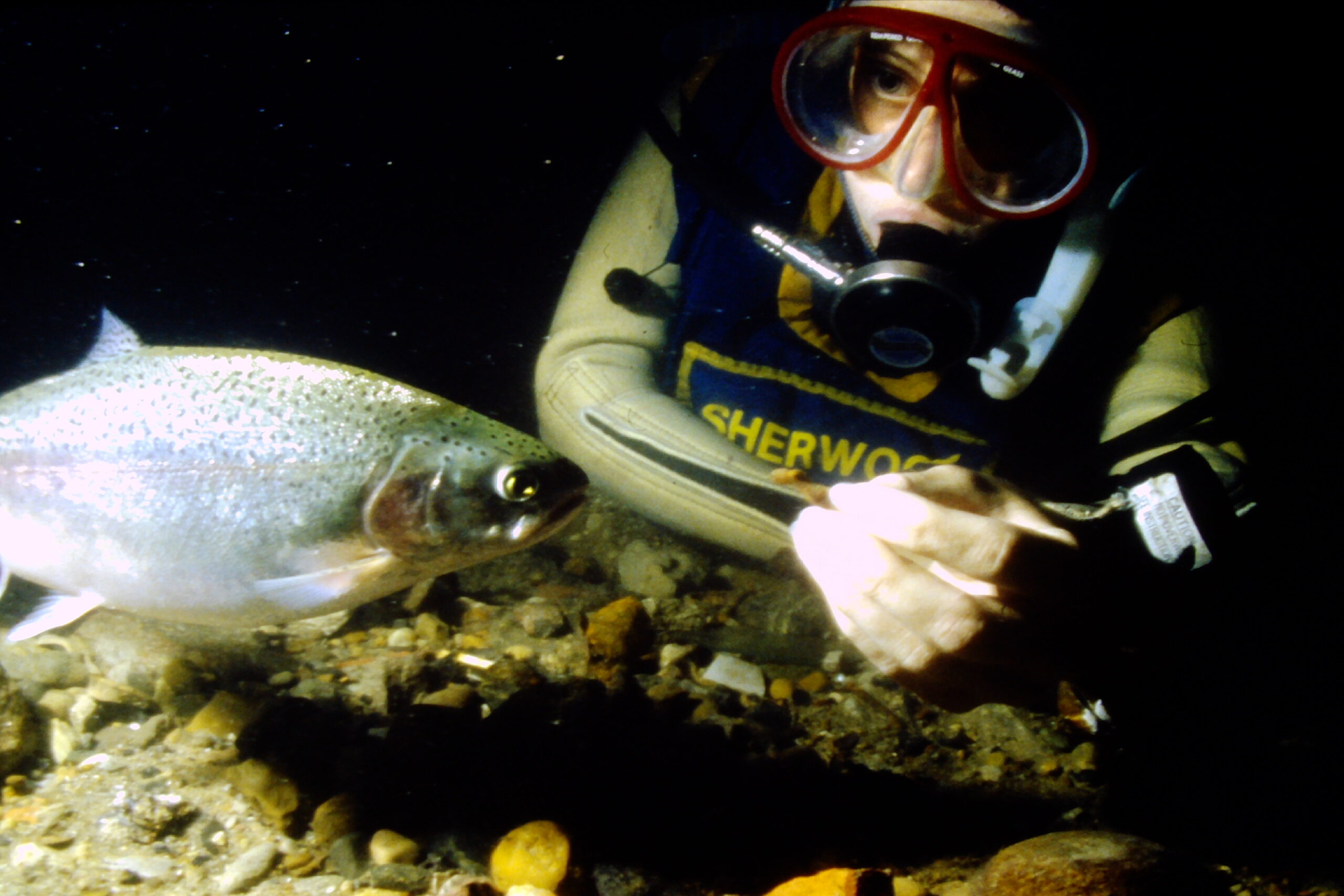
Kathy Johnson has been feeding rainbow trout in the Great Lakes for almost 30 years. (Photo courtesy of Kathy Johnson)
Divers feeding marine life became so popular in the 1980s and 90s that every dive resort started offering some type of encounter.
My first underwater fish-feeding experience was in the Bahamas. I was on a 65-foot liveaboard dive charter. The divemaster provided any diver who wanted to try feeding a goodie bag of table scraps from breakfast.
Of course, I gave it a try and it was a lot of fun. We mostly fed grunts.
Unfortunately, I’d take a pass today as feeding fish has proven very detrimental to reef ecosystems. This is why if you ask Alexa if feeding fish underwater is a good idea the answer will be a resounding: “no!”
I found a great article summarizing why feeding fish is bad for reefs. There are multiple negative impacts.
Often divers will release food into the water above a reef. This causes fish to swim up and leave the safety of their coral shelter and puts them at greater risk from predators. The food particles also settle back down onto the reef clogging its pores.
The type of food offered can also be problematic. Divers might enjoy pancakes with their bacon and eggs but feeding fish the wrong food can prove lethal.
Even if healthier food choices are offered, a problem persists. Fish that normally feed off the coral reef will often stop foraging and become reliant on the easier tableside service from divers.
A single diver offering food once every few weeks is not going to cause any fish to become dependent. But if a charter boat with 15 to 20 divers visits the same site twice each day, those fish are very likely to become dependent on divers and stop foraging naturally.
Each of these issues can cause the reef ecosystem to quickly get out of whack. Together they are all kinds of bad.
I agree with the prevailing scuba industry sentiment that it’s best to avoid resorts that promote fish-feeding encounters.
Since I’ve already admitted to feeding a variety of Great Lakes fish, am I a blatant hypocrite?
I don’t think so, as there are a few factors which make all the difference.
Healthy Dining
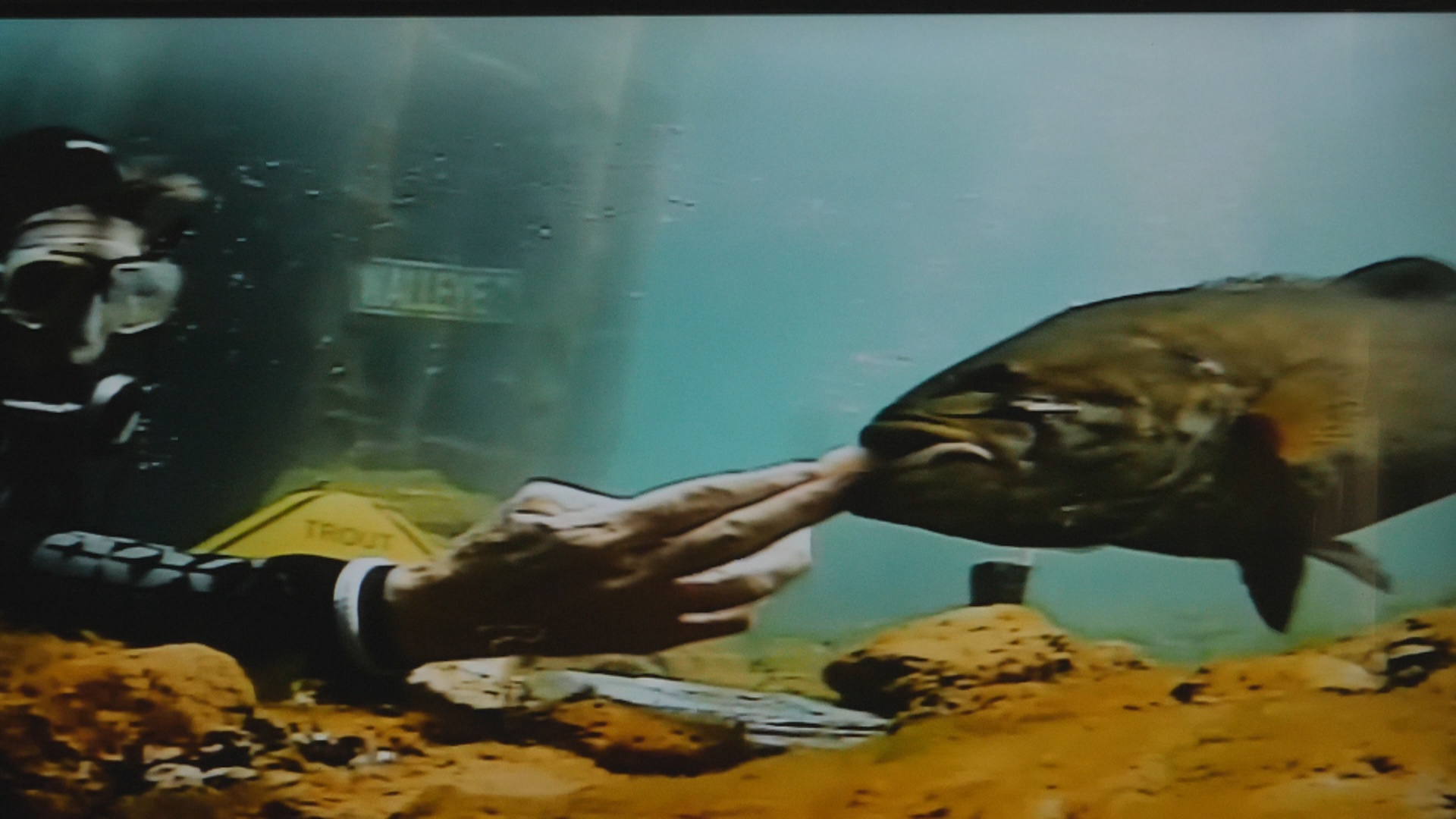
The PolkaDot Perch livestream camera captures the moment a smallmouth bass is hand-fed by a diver. (Photo Credit: Greg Lashbrook/PolkaDot Perch)
The most obvious difference between the fish feeding that I do and feeding reef fish is the lack of cascading impacts on the surrounding ecosystem. For starters, I do not draw fish away from their natural habitat. I go to them. I don’t lure them to me.
My feeding does not increase the risk of predation with perhaps the exception of round gobies. When they get feeding it does draw in the bass.
Thankfully, I don’t need to worry about harming a thousand-year-old living reef with food particles. However, offering the right food is still critical for the fish’s well-being.
I’ve seen divers feed fish everything from bacon to cheese in a can. Bread is another popular human food that people throw to fish. The problem is that if the fish does not have the necessary enzymes to digest the unnatural food, it can cause a lethal obstruction.
Fish, whether fresh or saltwater, don’t normally eat dairy, fried pork, or baked goods.
The difference is like giving potato chips to seagulls versus thistle to finches. Most would say the chips are not cool, but the thistle is fine.
Most of the time I offer nightcrawlers. I always purchase them from a local bait shop. I like to support local businesses and exchange fish stories.
Nightcrawlers are sold for fish consumption, although anglers could argue that the bait is meant to attract the fish not necessarily to feed them. But, if and when the fish get away with the worm, while the angler might be upset the fish will be fine.
My treats are just offered sans hooks.
I can think of ways that feeding fish in the Great Lakes could go wrong.
If shipwreck divers started feeding fish that could lead to problems similar to the coral reefs. If Great Lakes dive charters started dropping large groups of divers in the same spots to feed fish, that could have similar negative impacts as in the ocean.
Basically, on a commercial level feeding fish is not a good practice here, there, or anywhere.
My Rainbow Warriors
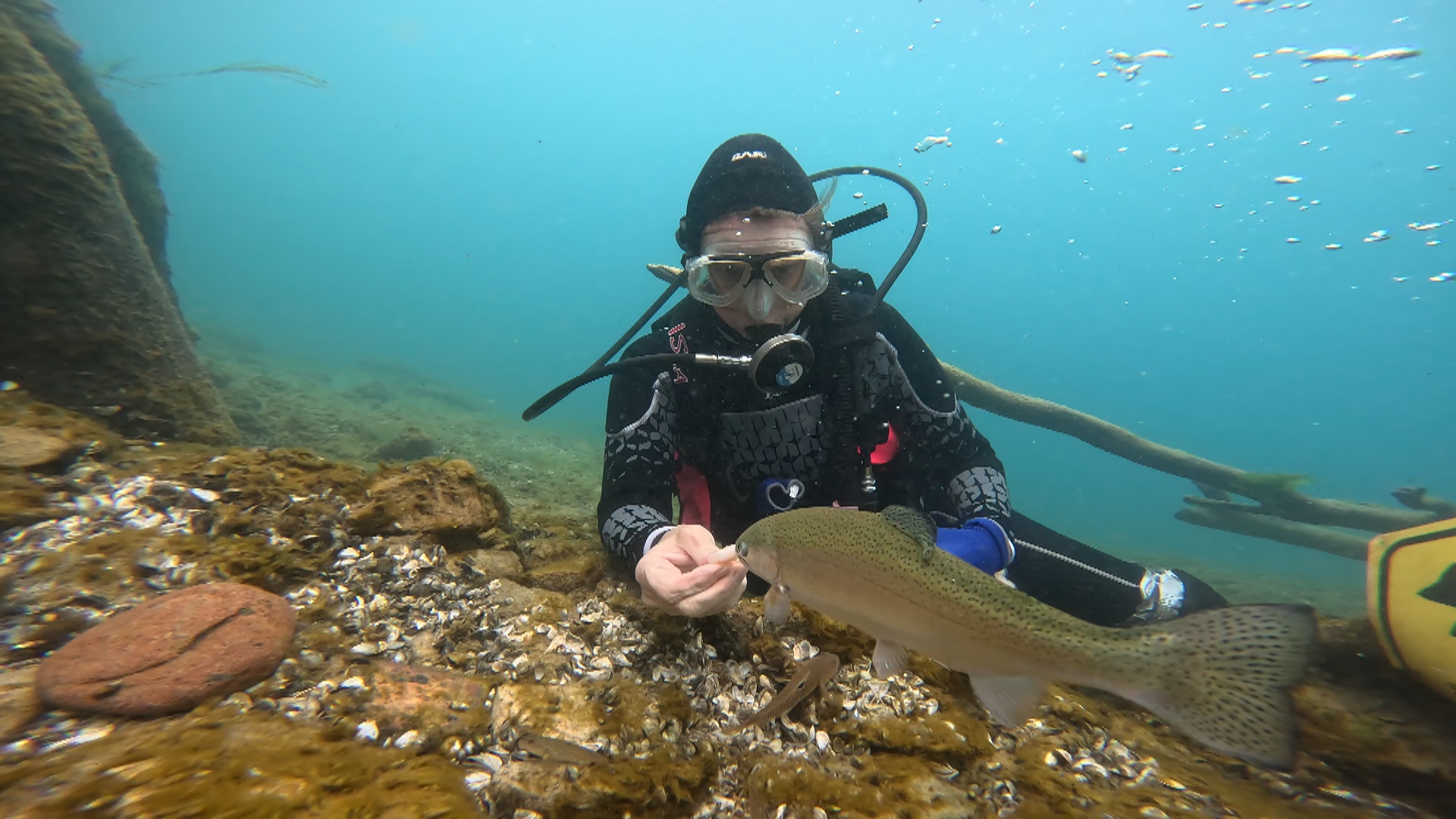
Rainbow trout are aggressive feeders but typically avoid close contact with divers. (Photo Credit: Greg Lashbrook/PolkaDot Perch)
So then, what if my feeding video went viral and suddenly hundreds of divers around the basin started feeding fish in different places? If they do it ethically, I think the advocacy for fish that they would gain is not the worst thing that could happen to Great Lakes fish.
When it comes to feeding any wild creatures, behavior conditioning needs to be considered from all perspectives. If a diver feeds hot dogs to a moray eel, the next unsuspecting diver that ventures too close might get their finger bitten.
Thankfully, I don’t have to worry about a trout attacking anyone. And my random feedings will not condition any fish to stop foraging in lieu of my return with more worms.
I know this because more than once I’ve returned to the same spot the following day to find the same fish as identified by size and visible markings. And they are not anxiously awaiting my return. They typically act like we’ve never met.
But does feeding them worms make them more likely to strike a worm on a hook and thus get caught? Not necessarily.
Just because they gobbled down a worm once does not guarantee they will do so again. The next time they are as likely to ignore it completely or try it and then spit it out like a toddler tasting peas for the first time.
The first rainbow trout I fed did love nightcrawlers.
By the end of the dive, I had a memory and picture that I thought would hold me for a lifetime. I’ve used the best shot from that first trout encounter as my profile picture for as long as I’ve had a Google profile.
I’ve seen plenty of trout since but I’ve never gotten another one to feed let alone from my hand. I’d accepted it as a once-in-a-lifetime experience that was not fated to be repeated.
Then last month, I spotted a couple of rainbow trout hanging around our Livestream camera and decided to try again. My expectations were admittedly low.
To my surprise and joy, the smallest of the rainbows decided to give the worms a try.
By the end of my dive, I had an upgraded memory and an updated profile pic.
Catch more news at Great Lakes Now:
I Speak for the Fish: The Quest for a Largemouth
I Speak For The Fish: Are muskies still the readers’ favorite?
Featured image: The first time Kathy Johnson hand-fed a rainbow trout was in 1995. (Photo courtesy of Kathy Johnson)




